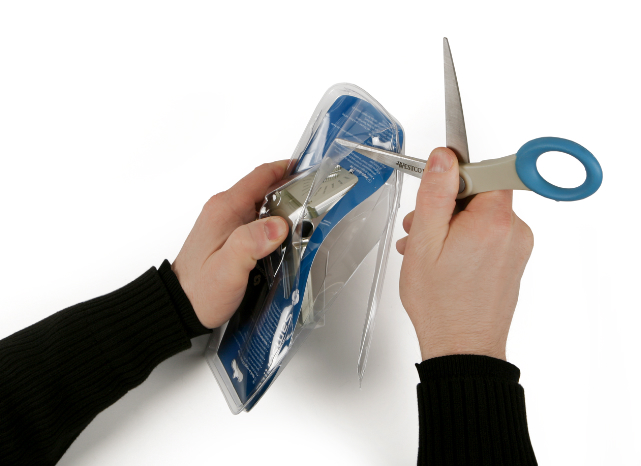Sealed Clamshell Packaging
by Andrew Boyd
Today, tightly sealed. The University of Houston presents this series about the machines that make our civilization run, and the people whose ingenuity created them.
I recently purchased some new, fluorescent light bulbs at the store. I found what I liked, brought them home, and as I began to open them it struck me: they were wrapped in sealed clamshell packaging.

An example of wrap rage. Photo Credit: Wikimedia Commons
You may not know it by name, but you've almost certainly encountered it. One molded, hard plastic sheet sits behind the contents, another in front. The surrounding edge of these two sheets is then sealed to form a clear, form-fitting package.
Problem is, the plastic is so thick, and the seal so tight, the packages are extremely tough to open. Tearing them apart with your hands is impossible. Box cutters and sharp knives are dangerous and don't work that well. A sturdy set of scissors is your best bet, but the plastic hurts to cut. One website recommends using tin snips. And the jagged plastic remnants have sharp edges. Who in their right mind, I asked, came up with this design?

Using scissors to try and open clam shell packaging. Photo Credit: Flickr
It's worth backing up to consider the goals of retail packaging. Packages not only keep their contents safe and secure, they also must attract the attention of customers. Clear plastic lets us see what's inside. Strong packaging can also reduce theft. Still, doesn't the pain outweigh the gain when it comes to sealed clamshell packaging?
For the purchasing public, yes. Reflecting the growing "wrap rage" trend, in 2007, Consumer Reports bestowed "oyster awards" on difficult to open packages. Topping the list was a boxed electric toothbrush sealed in tight-fitting plastic -- a clamshell so tight there was nothing for scissors to grab onto. Every year, thousands of people make their way to emergency rooms having been injured by difficult to open packages.
Credit for clamshell packaging is sometimes given to Thomas Jake Lunsford and a 1978 patent. In the patent, he explains how his design is an improvement over what we now call blister packaging. Blister packaging uses a clear, form fitting plastic sheet on the front, but on the back it's attached to a piece of paperboard. Household batteries are commonly sold this way, and they're much less painful to open since the paperboard easily peels away from the plastic.

The front and back of a blister package around batteries. Photo Credit: Andy Boyd
Interestingly, while Lunsford replaced the paper backing with form fitting plastic, he didn't propose that the two plastic molds be tightly bonded together. Instead, his patent claims the molds should form a "snug fit" so that when pressed together they form a "vacuum lock." Lunsford goes on to imply the packaging should be reusable, and therefore pull-apart, not welded together.
We may never know the exact origins of sealed clamshell packaging or how it came to be so popular. It's now in decline as powerhouse retailers like Amazon weigh in. But for the near future it appears we'll just have to suffer the slings and sharp edges of outrageous fortune.
I'm Andy Boyd at the University of Houston, where we're interested in the way inventive minds work.
(Theme music)
For a related episode, see PACKAGING AND WASTE.
The term "clamshell" is used both for the molded, sealed packaging discussed in this article, but also for any package that hinges liked a clam; for example, the boxes used in many fast food restaurants to serve hamburgers. 'Blister' packaging is frequently associated with pills, but more generally refers to a larger class of packaging with plastic attached to paper.
"2007 Oyster Awards: Consumer Reports Adds Inductees to their Hard-to-Open Packaging Hall of Shame." Chatham Journal, February 24, 2007. See also: http://www.chathamjournal.com/weekly/living/home/cr-oyster-awards-70224.shtml. Accessed May 13, 2015.
How to Open Plastic Packaging (Without Hurting Yourself). From the Money Talks News website: http://www.moneytalksnews.com/how-to-open-plastic-packaging-without-injuring-yourself/. Accessed May 13, 2015.
Separable Packaging and Display System. U.S. patent number 4091927 A. Available through the U.S. Patent Office or at the website: https://www.google.com/patents/US4091927. Accessed May 13, 2015.
B. Stone and M. Richtel. "Packages You Won't Need a Saw to Open." New York Times, November 14, 2008. See also: https://www.nytimes.com/2008/11/15/technology/internet/15packaging.html?_r=2&. Accessed May 13, 2015.
This episode was first aired on May 21, 2015